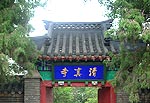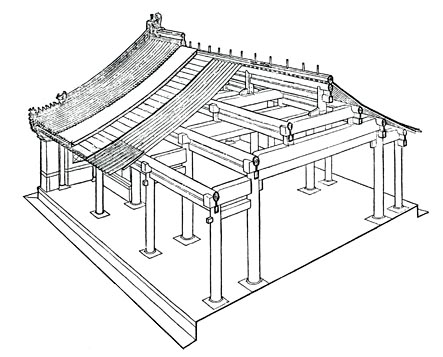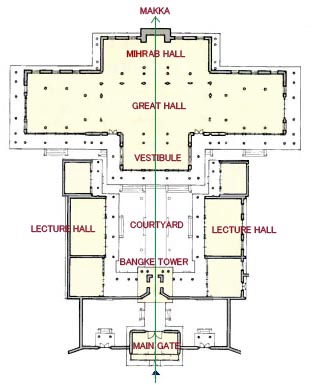| FEATURES
|
TAKEO KAMIYA

(UNACCOMPLISHED)
|
There are as many as twenty three million people who believe in Islam dispersed all over China. Islamic architecture therefore is also scattered throughout the whole country and according to the statistics the number of mosques alone exceeds 35,000.
On the contrary, the Chinese inland Muslims are not discernible from Han Chinese except by their faith, because they have intermarried with Han people and have taken to speak Chinese, although they had originally come from the west; Arabia, Persia, Turkey and so on.
Historically the Islamic Empire has never conquered China. Apart from the age of Yuan Dynasty when Muslims were given preferential treatment, called as the ‘Semu (literally meaning ‘color-eye’) People,’ Hui People have almost always been dominated by Han Chinese.
There was no other way but the Islamic architecture of Chinese inland was realized by assimilating with Chinese traditional ways of erection and styles. It can be said it is more suitable architecture for the verdurous climate of China, being different from the desert climate in the Middle East. 
Islam was introduced into China by land and by sea. The main land route was the so-called ‘Silk Road’ for caravan traders and although there were small military invasions and local subjugations, they were limited to the Xinjiang Uyghur region only. Rather sea routes developed early on, bringing Muslim traders who would form Muslim communities in various coastal cities.
The first contact between China and Islam was the dispatching of diplomatic envoys from the country of Dashi (Chinese name for Arabia) to the emperor Gaozong of the Tang Dynasty in 651 A.D. Speaking the year 651, since it was just 20 years after the death of Muhammad and during the age of the 3rd Khalif (Caliph) Uthman of Rightly Guided Khalifate, it was extremely early. It was 10 years before the beginning of the Umayyad Dynasty. Historically known mosques in the early stages were built in such trade port cities along the southern cost. Above all the four famous mosques have been called by animal nicknames, these are the Giraffe Mosque in Quanzhou, the Lion Mosque in Guangzhou, the Phoenix Mosque in Hangzhou, and the Crane Mosque in Yangzhou. Some of them are said to have been erected in the Tang Dynasty, but they were actually erected between the Song Dynasty (960-1279) an the Yuan Dynasty (1260-1368). In this web page to introduce Chinese Islamic architecture, I have divided the whole country into three areas. The first chapter is applied to ‘Southern China’ including those four great mosques in the costal cities. The next chapter concerns ‘Western China’ that includes Central Asian styles in the Xinjiang Uyghur Autonomous Region. The third chapter covers ‘Northern China’ that describes the Chinese style mosques centering on Beijing. On top of that I will add a chapter to elucidate the general features of the Chinese Islamic architecture in comparison to that of other regions in the world of Islam. By the way, ‘Uyghur’ People in the Tang Dynasty were written as 回纥 or 回鶻 in Chinese by transliteration, and later it was diverted into 回回 pronounced as ‘Hui hui.’ Although the Uyghur People had believed in Manichaeism in those days, they were gradually Islamized starting the 10th century. In accordance of that the word ‘Huihui’ changed to indicate Muslims, then from the Ming Dynasty (1368-1644) Islam was referred to as 回回教 (Huihui jiao) or abbreviated 回教 (Hui jiao) and Muslims were referred to as 回民 (Hui ming, people of Islam) or 回族 (Hui zu, ethnic group of Islam) till recent years.
In current times the original ‘Uyghur’ People are considered separate from the group currently referred to as the Hui People and it is transliterated as 维吾尔. Since there were occasions that local political powers were established in the Xinjiang Uyghur Region, mosques in the same style as those in the neighboring Central Asia were built in the Xingjiang cities like Kashghar or Turfan. Thus the Islamic architecture in China has come to be roughly separated into two categories; Inland Chinese style by the Hui People and Western style by the Uyghur People. 
The word 回教 (Hui religion) signifies literally ‘the teachings of Islam,’ the same nomenclature as 仏教 (the teachings of Buddha). Though there was also the name 清真教 (Pure and True religion), the word 回教 spread largely as a representative ‘kanji’ for Islam even into Japan.
As for mosques, since they were regarded as ‘寺 (temples)’ like other religion’s facilities, they all are referred to as ‘○○寺.’ Although there was a general nomenclature as 回回寺 (Huihui temple) in the Song and Yuan Dynasties, many mosques were given free style proper names like the aforementioned four great mosque in the southern coastal cities (the Shengyou Mosque in Quanzhou, the Huaisheng Mosque in Guangzhou, the Zengjiao Mosque in Hangzhou, and their animal nicknames). The reason is unclear why they avoid giving mosques distinct proper names, but they often refer to them by their locations or directions in their cities, as Eastern Great Mosque or Southern Great Mosque, or by the names of the road in front of them, as ‘Niujie’ Mosque in Beijing or ‘Huajuexiang’ Mosque in Xian. There were tens of thousand of mosques in China, but due to the habit of reconstructing temples to improve or enlarge them regardless of religions each time the dynasties had changed, vanishing by wars or fires, belittling religions by communist revolution, and thorough demolitions by the Cultural Revolution, the number of existing old mosques are astonishingly few in spite of its vast extent of land. Now I will introduce Islamic architecture in southern China in geographical order from east to west, bestowing a number to each city on the map in order to confirm the location of each edifice. The names of each city and edifice are asterisked showing the degree of its architectural importance and attractiveness as the same manner in the book “The Guide to the Architecture of the Indian Subcontinent.”
This web page is written as a continuation of my book "Architecture of Islam". But this book is prevented from publishing by Mafia's interference, in which the publisher, Shoukoku-sha publishing company, has audaciously denied to publish it in defiance of the contract of the publication.
 © Takeo Kamiya E-mail to: kamiya@t.email.ne.jp
|